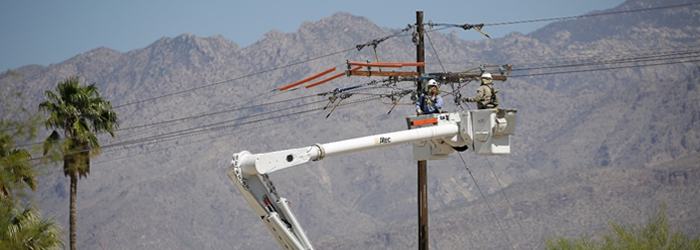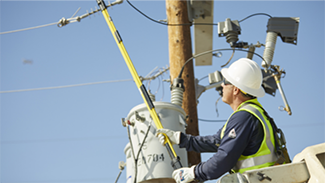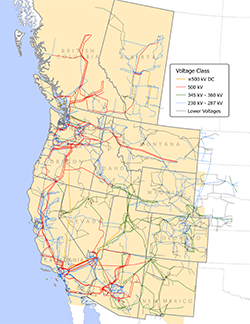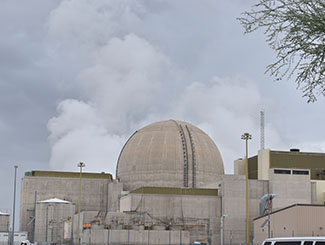Security of the Electric Grid System in Arizona
 15 June 2021
15 June 2021 

Security of the Electric Grid System in Arizona
The summer of 2020 was particularly challenging in Arizona. Our state experienced the hottest summer on record – 14 days at or above 115 degrees, 53 days at or above 110 degrees, and 28 days with low temperatures of 90-plus degrees – all record-shattering numbers. This week’s forecast is expected to be 118 in the Metro Phoenix area and 113 degrees in Metro Tucson, while those lucky folks in Flagstaff will only be in the mid-80s.
Extreme temperatures can put a strain on local energy grids. In the summer of 2020, extreme heat and inadequate planning led to a regional energy shortage that affected customers in California. Demand exceeded supply after sunset. The flexibility to buy and sell energy in the region was constrained because each electric company needed its own energy to serve its customers. As a result, California’s utility companies experienced rolling blackouts and energy shortages.
On the other end of the thermostat in February 2021, more than 4.8 million customers in Texas were without power during a winter storm that plunged large parts of the state into single-digit temperatures.
The Texas Tribune reported April 21, 2021 “The Electric Reliability Council of Texas, which operates the state’s main power grid, ordered utility companies to cut power during the February winter storm because demand was outpacing supply so much that it threatened the entire grid. But when utility companies complied, they shut off electricity to natural gas facilities, preventing them from delivering fuel to power plants.
Could a situation similar to Texas or California’s happen in Arizona?
Hello Sunshine!
Arizona is served primarily by these utilities: Arizona Public Service Company (APS), Tucson Electric Power (TEP), and UniSource Energy Services (UNS). APS is the largest electric utility with more than 1.3 million customers in 11 of the 15 counties in the state. TEP serves over 433,000 customers in southern Arizona. UniSource reports more than 98,000 residential and business electric customers in Mohave and Santa Cruz counties. APS and TEP are investor-owned utilities regulated by the Arizona Corporation Commission.
 In addition, Salt River Project (SRP) was established by Federal Reclamation Act to manage the Verde and Salt River watersheds and is government owned. As hydroelectric dams were built along the Salt River, SRP expanded to offer power supply and today operates natural gas and steam power generation stations and owns 17.5% of Palo Verde Nuclear Generating Station and services over 1 million customers.
In addition, Salt River Project (SRP) was established by Federal Reclamation Act to manage the Verde and Salt River watersheds and is government owned. As hydroelectric dams were built along the Salt River, SRP expanded to offer power supply and today operates natural gas and steam power generation stations and owns 17.5% of Palo Verde Nuclear Generating Station and services over 1 million customers.
Arizona utility companies live by “summer is our season.” They spend all year preparing for the summer heat, monsoon storms, and wildfires. They continuously monitor power flow.
Meeting supply and demand is a constant struggle. To effectively serve seven million people, Arizona's utility companies must track minute by minute customers’ real-time energy needs while anticipating how those needs will change. Energy isn't like water that can be stored in a dam for future use.
“We ready our resources and ready our people. Reliability and planning are at the core of what we do,” says Jacob Tetlow, Executive Vice President, Operations, Arizona Public Service Company (APS). “We have teams focused on planning long-term and several years in advance as it’s our responsibility to maintain a diverse supply of resources and effectively manage our system to keep customers supplied with electricity during challenging times.”
Chris Hoffman, director of Transmission and Generation Operations for Salt River Project (SRP), agrees. “We are used to dealing with it. We take the lessons from each summer and implement them so we can meet the need.”
 Joseph Barrios, Spokesperson, Tucson Electric Power (TEP), is often asked whether they have enough power. Like APS and SRP, TEP looks at past energy use, weather patterns and other factors to ensure that they do.
Joseph Barrios, Spokesperson, Tucson Electric Power (TEP), is often asked whether they have enough power. Like APS and SRP, TEP looks at past energy use, weather patterns and other factors to ensure that they do.
A significant difference between Arizona and Texas is that Texas is its own isolated “power island.” It runs its own electrical grid that is not connected to other states.
“We are fortunate that Arizona is part of the Western Interconnection,” says Barrios. “In the western grid, if a company requires additional resources, they can turn to one of their neighbors for help.”
North America is comprised of two major and three minor alternating current (AC) power grids or “interconnections.” The Western Interconnection stretches from Western Canada south to Baja California in Mexico, reaching eastward over the Rockies to the Great Plains. The electric utilities in the Western Interconnection are electrically tied together during normal system conditions and operate at a synchronized frequency.
The benefit of this is, for example, when it's 118-degrees in Phoenix this week, it will only be in the mid-70s in Seattle. They may have a surplus of electricity they sell to Arizona if the need presents itself.
"We all in similar circumstances," says Barrios. "When summer comes along, we have to make additional purchases to satisfy our customers’ energy needs. Given what happened last summer, TEP worked very hard to secure adequate resources."
Planning for Future Use
Arizona is home to Palo Verde Generating Station, the nation’s largest producer of clean, carbon-free electricity. APS operates the power plant and both APS and SRP have ownership in the plant, which produces enough electricity each year to power four million homes and businesses in the Southwest. Other power resources that make up Arizona’s energy mix include hydroelectric, solar, natural gas, wind, coal, and biomass (converting wood products to steam). Despite Arizona’s continued population growth, a new nuclear power plant is not on the horizon.

APS is also exploring the potential use of hydrogen as a clean energy source and is already halfway to its 2050 goal of providing customers with 100 percent clean energy. It has a 2030 target of 65-percent clean energy, 45 percent of the generation portfolio coming from renewable energy. SRP plans to cut emissions by 62 percent by 2035 and 90 percent by 2050. TEP is working to provide more than 70 percent of its power from wind and solar resources while reducing carbon emissions by 80 percent by 2035.
Consumers Can Play Their Part
Start with a whole-house energy audit. Learn where your home is losing energy and make corrections. It may be as simple as caulking a window seal, but it helps.
Sign up for a staggered energy plan. Reduce your energy usage by optimizing on and off peak energy.
Learn to Supercool- Rosie’s been touting this one for years!
- Turn your AC down as low as you can stand it (68-74 degrees) during your off-peak hours. This will cool your whole house down to the studs.
- Turn your AC up as high as you can stand it (78-85 degrees) during your on-peak hours. This will allow your AC to shut off and save money during the most expensive time of day. The coolness you built up during your off-peak hours should last well into the evening before the AC needs to cool you down again.
Supercooling works best with homes that are reasonably built and insulated.
Use a fan to cool your body instead of the entire house.
The utility companies offer a variety of energy and money-saving plans.
APS
 APS’s Saver Choice time-of-use (TOU) plans offer customers the greatest opportunity for savings by shifting their energy use to lower cost off-peak hours before 3 p.m. and after 8 p.m. weekdays, all weekend long and on 10 holidays. Standard service plans offer round-the-clock pricing so energy costs the same no matter when you use it.
APS’s Saver Choice time-of-use (TOU) plans offer customers the greatest opportunity for savings by shifting their energy use to lower cost off-peak hours before 3 p.m. and after 8 p.m. weekdays, all weekend long and on 10 holidays. Standard service plans offer round-the-clock pricing so energy costs the same no matter when you use it.- For a limited time, APS is offering residential customers who enroll in APS Cool Rewards, a free ENERGY STAR®-certified ecobee3 lite smart thermostat, valued at $169. More than 44,000 thermostats are enrolled in the program which adjusts smart thermostats a few degrees on hot summer days when energy usage is high. Customers still have the flexibility to control their thermostat devices and can opt-out of a Cool Rewards event at any time. Customers receive $75 in bill credits the first year and a $25 participation bill credit per thermostat annually. To enroll and order your free thermostat, visit the APS Marketplace at myaps.store/tstats. Customers only pay shipping costs and taxes.
SRP
- With the SRP EZ-3 Price Plan™, you can save money and stay cool and comfortable year-round when you plan ahead to use less energy from 3–6 p.m. or 4–7 p.m. on weekdays. These are on-peak hours when SRP's energy costs are higher. You'll pay lower off-peak prices all other hours, including weekends and six observed holidays.
- With the SRP Time-of-Use™ (TOU) Price Plan, you can save money on your electric bill by using less electricity weekdays from 2–8 p.m. between May and October. Between November and April, higher cost on-peak hours are weekdays from 5–9 a.m. and 5–9 p.m.
- SRP's Basic Price Plan is ideal for customers who typically don't use a lot of energy, are seasonal visitors, or find that other plans aren't a good fit for their lifestyle and household. Energy prices are the same no matter when you use energy. Prices go up slightly when energy usage in a month exceeds certain levels, which vary in summer.
TEP
- TEP’s time-of-use (TOU) and demand plans offer lower energy rates during off-peak periods but higher costs during on-peak hours. From October 1 through April 30, on-peak periods are weekdays from 6:00 a.m. to 9:00 a.m. and 6:00 p.m. to 9:00 p.m. From May 1 through September 30, on-peak hours are weekdays from 3:00 p.m. to 7:00 p.m.
- TEP’s Basic plan’s energy charges do not vary by time of day, so customers don’t need to worry about when they use electricity. But those charges are higher than the off-peak rates on our TOU and demand-based plans, so customers should be aware that switching to the Basic plan could result in higher bills.
- TEP’s Marketplace offers items for purchase such as smart thermostats, ENERGY STAR® lighting fixtures, and LED bulbs, smart power strips, air cleaners, humidifiers and dehumidifiers, portable fans, room air conditioners, and smart home devices.
Most energy providers offer different plans. Check with the one that powers your community.
“If we can level off the peaks, we will go a long way to stretch our current supply,” says Barrios. “We (energy suppliers) know our customers are counting on us.
###
Podcast
A roundtable discussion of Arizona's electric grid with Salt River Project (SRP) and Arizona Public Service (APS). After the fires in California last summer and the Texas Deep Freeze this year, can our power grid face similar challenges during the summer desert heat? The planning and challenges both utilities face every summer makes our grid very different from those events. From making electricity, distribution and management, it's a very efficient system.
Photo Credit
- Arizona Public Service
- Tucson Electric Power
- Western Interconnection
- Jen Gura; Rosie on the House
- Shutterstock
Related Content
- Video: Central Arizona Project (CAP) Helicopter Tour
- Blog: Rosie On The House Tour Of Palo Verde Nuclear Generating Station
- Tucson Electric Power (TEP)
- Arizona Public Service (APS)
- Salt River Project (SRP)
- Trico Energy Cooperative
- UniSource Energy Services
- Navopache Electric Cooperative
- Sulphur Springs Valley Electric Cooperative
- azfamily.com: Texas Power Outage Disaster Raises Concerns About Whether It Could Happen In Arizona
Print this page
recent post
- Duck, Duck, Duct! How Often Should Ductwork Be Cleaned?
- Vinyl vs. Fiberglass Windows: Which Is The Better Choice Of Replacement Window?
- We May Be The Grand Canyon State, But The Rocky Mountains Are Important For Arizona
- Welcome to Arizona! Things A Newbie to Arizona Should Know
- The Pros & Cons of Buying A Flipped House
- Getting In On The Ground Floor
- Why It’s More Critical Than Ever To Get Your AC Serviced Before Summer
- The Reality of Remodeling
- What To Look For When Comparing Your Roofing Quotes
- What To Expect When Buying New Windows & Doors
